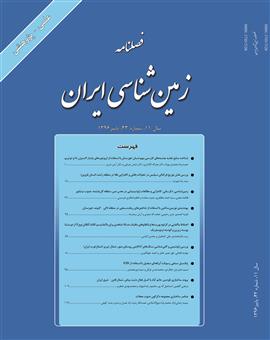تاثیر شیب مرزهای نفوذناپذیر در منحنی افت-زمان در اطراف یک چاه پمپاژ در آبخوان¬های محبوس
محورهای موضوعی :آرش ندری 1 , عزت اله قنواتی 2 , نصرالله کلانتری 3
1 - دانشگاه شهید چمران اهواز
2 - خوارزمی
3 - دانشگاه شهید چمران اهواز
کلید واژه: مرزهای نفوذناپذیر داده¬, های افت- زمان آبخوان محبوس شبیهسازی عددی چاه¬, های مجازی ,
چکیده مقاله :
بررسی تاثیر مرزهای نفوذناپذیر بر جریان به چاه های نزدیک به آن با استفاده از تئوری چاه های مجازی انجام می گیرد. در مواردی که مرزهای نفوذناپذیر مطالعه شده اند، این مرزها بهصورت عمودی در نظر گرفته شده اند درحالیکه در بسیاری موارد عمودی نبوده و شیب دار هستند. در این مطالعه هدف بر آن است که تاثیر شیب مرزهای نفوذناپذیر بر جریان به چاه در یک آبخوان محبوس بررسی شود. در این مطالعه شبیه سازی عددی و نیز محاسبات افت با استفاده از روش چاه های مجازی برای مرزهای عمودی انجام شده و سپس شبیه سازی جریان برای مرزهای شیبدار انجام شد. مدل مفهومی مورد نظر شامل یک آبخوان محبوس است که توسط دو مرز نفوذناپذیر محصور شده است و یک چاه با دبی ثابت در آن پمپاژ می شود. فاصله بین مرزها در فاصلهای از400 تا 10000 متر قرار گرفته است. شبیه سازی نشان داد که درصورتیکه مرزهای نفوذناپذیر و محدودکننده عمودی باشند تطابق بسیار عالی بین نتایج شبیهسازی عددی ازیکطرف و استفاده از رابطه تایس و تئوری چاه های مجازی از طرف دیگر وجود دارد. منحنی های افت زمان برای مرزهای نفوذناپذیر شیبدار تفاوت قابلتوجهی در زوایای مختلف و نیز عرض های مختلف (10000 تا 400 متر) با نتایج حاصل از مرزهای عمودی نشان دادند. نتایج نشان داد اگر فاصله مرزهای نفوذناپذیر زیاد باشد و مرزهای نفوذناپذیر دارای زوایای کمتر از 30 درجه باشند، تفاوت ها به حدی است که تقریب استفاده از روش چاه های مجازی می تواند قابلقبول باشد. اما هنگامیکه فاصله بین مرزها کمتر باشد حتی در زوایای کم نیز تفاوت قابلملاحظهای در مقادیر افت- زمان مرزهای شیبدار با نتایج روش چاه های مجازی وجود دارد.
The image well theory was used in the study of no flow boundaries effects on the drawdown around pumping wells. Most studies are concentrated on the vertical no flow boundaries, while, in some cases these boundaries are not vertical and have inclinations. To the best of the authors knowledge, the problem of the inclined no flow boundaries has not been studied yet. The effects of the parallel no flow boundaries inclination on the drawdown around pumping wells in bounded aquifers is studied here. The time-drawdown data for vertical boundaries have used the numerical simulation and also the image well theory. The effects of inclination of the boundaries were only considered using the numerical simulation. The results of numerical simulations and image well theory for vertical no flow boundaries were matched completely. The computed drawdown for observation well in the models with inclined and vertical no flow boundaries used to compute the difference between them. The difference between these cases depends on the distance between the boundaries (width of the aquifer) and the inclination value. The results showed that in large widths and low inclinations, the computed drawdown in aquifers with vertical boundaries are almost similar with the computed drawdown in aquifers with inclined boundaries and the differences can be neglected. In the other words, the difference between the vertical and inclined cases in smaller widths is so high that even in the low inclinations, the differences can't be neglected. It can be concluded that the image well theory as we know, cannot be used in inclined no flow boundaries.


